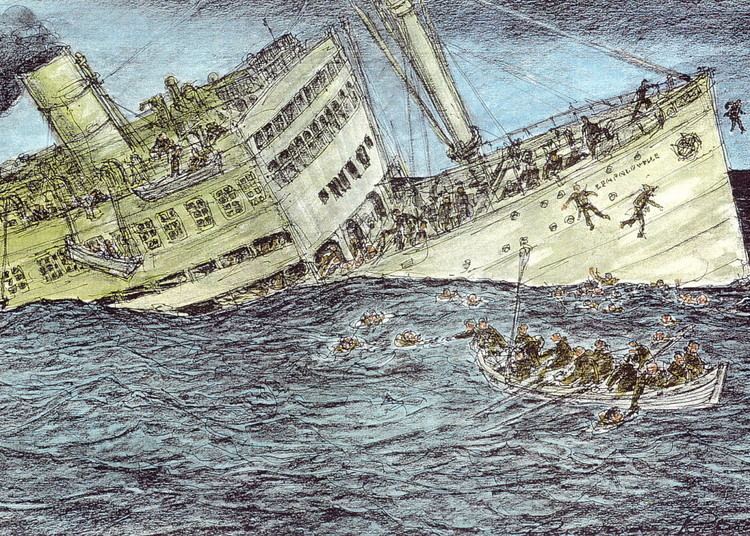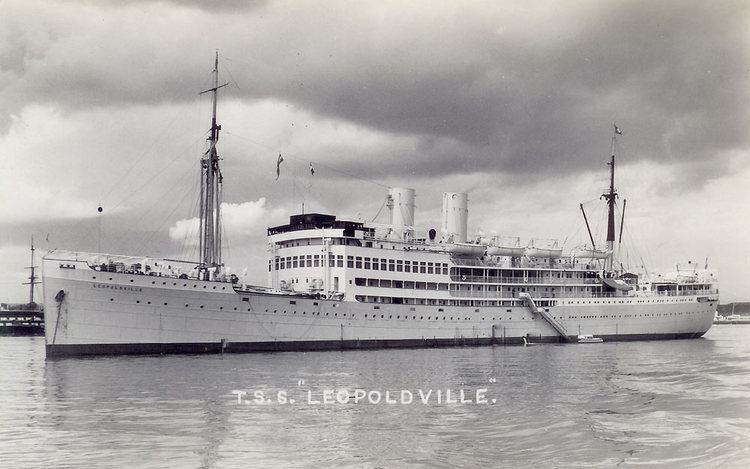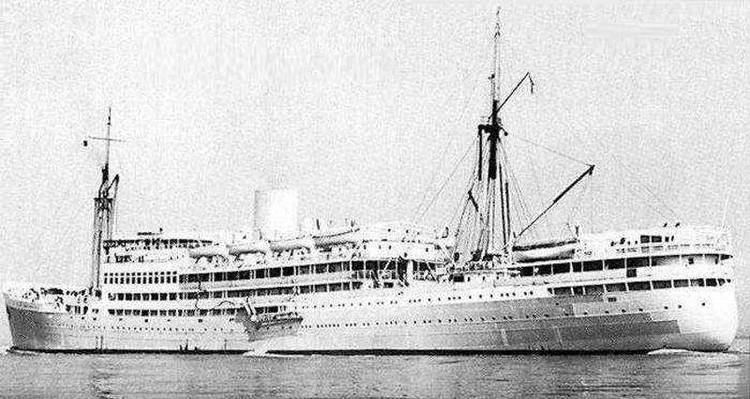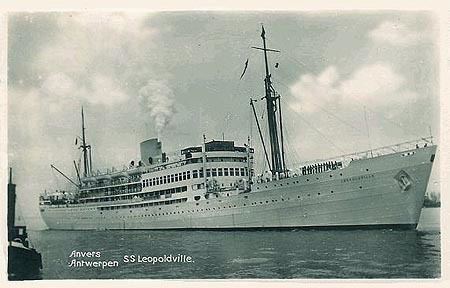Name SS Léopoldville Length 146 m Beam 19 m | Port of registry Antwerp Draft 7.87 m Completed 1929 | |
 | ||
Operator Compagnie Belge Maritime du Congo
(Later Compagnie Maritime Belge (Lloyd Royal) SA), Antwerp Identification Belgian Official Number 120.
Code Letters MLFP (1929-34)
Code Letters ONLB (1934-44) Fate Sunk on 24 December 1944 Tonnage 11,256 GRT, 6,521 NRT (1919-37)
11,509 GRT, 6,941 NRT (1937-44) Builders John Cockerill, Hoboken, Antwerp | ||
SS Léopoldville was a 11,509 GRT passenger liner of the Compagnie Belge Maritime du Congo. She was converted for use as a troopship in the Second World War, and on December 24, 1944, while sailing between Southampton and Cherbourg, was torpedoed and sunk by the U-486. As a result, approximately 763 soldiers died, together with 56 of her crew.
Contents

Description

Léopoldville was 478 feet 8 inches (145.90 m) long, with a beam of 62 feet 2 inches (18.95 m). She had a depth of 35 feet 0 inches (10.67 m) and a draught of 25 feet 9.75 inches (7.8677 m). She was assessed at 11,256 GRT, 6,521 NRT. The ship was propelled by an 1,019 nhp two 4 cylinder Quadruple expansion steam engines which had cylinders diameters of 28 25⁄16 inch (73.5 cm), 33 7⁄8 inch (86 cm), 48 7⁄16 inch (123 cm) and 68 7⁄8 inch (175 cm) diameter by 48 7⁄16 inch (123 cm) stroke. The engines drove twin screw propellers. She had 8,458 cubic feet (239.5 m3) of refrigerated cargo space.
Origins
She was built for the Compagnie Maritime Belge as the fifth to bear the name Léopoldville and initially served on the route between Belgium and its African colony, the Belgian Congo. She was allocated the Belgian Official Number 120 and the Code Letters MLTP. In 1934, her Code Letters were changed to ONLB. In 1937, she was reassessed as 11,509 GRT, 6,941 NRT.

Léopoldville was chartered by the British Admiralty in 1939. After converting the cargo hold to austere ferry benches, the ship completed 24 cross-Channel crossings, transporting more than 120,000 troops. A 24-man DEMS detachment manned defensive guns. The ship's Belgian crew, including 93 Africans from the Belgian Congo, received orders in Flemish. Captain Charles Limbor, who assumed command in 1942, spoke no English.
Sinking

Léopoldville was hastily loaded for the Battle of the Bulge with 2,223 reinforcements from the 262nd and 264th Regiments, 66th Infantry Division of the United States Army. The soldiers' regimental command structure was fragmented by loading troops as they arrived rather than according to their units. There were an insufficient number of life jackets, and few troops participated in the poorly supervised lifeboat drill as Léopoldville sailed from Southampton at 09:00 24 December as part of convoy WEP-3 across the English Channel to Cherbourg. The Léopoldville was in a diamond formation with four escorts; the destroyers HMS Brilliant and HMS Anthony, the frigate HMS Hotham, and the French frigate Croix de Lorraine, and another troopship the SS Cheshire.

Léopoldville was within five miles from the coast of Cherbourg at 17:54 when one of two torpedoes launched by U-486 struck the starboard side aft and exploded in number 4 hold killing about three hundred men as compartments E-4, F-4 and G-4 flooded. Few American soldiers understood the abandon ship instructions given in Flemish. While some soldiers joined the crew in departing lifeboats, many did not realize the ship was slowly sinking, and stayed aboard anticipating the ship would be towed ashore by a tug. While the other escorts searched for the U-boat, HMS Brilliant came alongside the sinking ship. Soldiers on the Léopoldville jumped down onto the smaller Brilliant. The destroyer could take only five hundred men and headed for the shore leaving some twelve hundred soldiers aboard.
Jack Dixon was a young seaman on board HMS Brilliant. At just 21 years old, he and others crew members battled against the conditions to try and rescue as many of the soldiers as possible. From his web site:
"H.M.S. Brilliant went along the port side of the troopship we had put our starboard fenders over the side; the sea swell was causing a rise and fall of between 8ft and 12ft. The scrambling nets were hanging down the Léopoldville 's port side and the American soldiers were coming down on to our upper deck. Some men had started to jump down from a height of approximately 40 feet. Unfortunately limbs were being broken when they landed on the torpedo tubes and other fixed equipment on the starboard side of the upperdeck; some men fell between the two vessels and were crushed as the two vessels crashed into each other. To avoid any further injuries, if possible, all our hammocks were brought up from our mess-decks below and laid on the starboard upper deck to cushion the fall of the soldiers as they landed. "
While the escorts focused on the searching for the U-boat and rescuing survivors, they failed to respond to blinking light signals from Cherbourg. Brilliant attempted radio communications, but could not communicate directly with the Americans at Fort L'Ouest in Cherbourg because the Americans used a different radio frequency and could not read the British code. Brilliant contacted HMNB Portsmouth and Portsmouth telephoned Cherbourg; but shore post communications, decisions, and orders were significantly slowed by minimal staffing during attendance at holiday parties. It took nearly an hour for Cherbourg to learn Léopoldville was sinking. Several hundred Allied vessels in the harbor at Cherbourg might have served as rescue craft, but all had cold engines while many of their crewmen were ashore celebrating the holiday. Allied forces enjoying their Christmas Eve dinner in Cherbourg failed to mobilize a rescue effort before Léopoldville sank by the stern at 20:40. Belated efforts by ships including USS PC-1225 rescued some survivors. In 1998 the History Channel broadcast the documentary film "Cover Up: The Sinking of the SS Léopoldville" which included interviews with numerous survivors of the sinking of the ship from the 66th Infantry Division and sailors from the US Navy who attempted to save them by pulling them out of the water. The sailors claimed that they arrived after the sinking of the ship and that most of the men who they pulled out of the water had already frozen to death in the water by the time they arrived on the scene.
Of the 2,235 American servicemen on board, approximately 515 are presumed to have gone down with the ship. Another 248 died from injuries, drowning, or hypothermia. Captain Charles Limbor, one Belgian and three Congolese crewmembers also went down with the ship. An unknown number of British soldiers died. Documents about the attack remained classified until 1996. The soldiers of the 66th Infantry Division were ordered not to tell anyone about the sinking of the ship and their letters home were censored by the Army during the rest of World War II. After the war, the soldiers were also ordered at discharge not to talk about the sinking of the SS Léopoldville to the press and told that their GI benefits as civilians would be canceled if they did so.
Discovery of the wreck
In July 1984, Clive Cussler of NUMA claimed to have discovered the wreck, although French maritime officials claim the location of the shipwreck had always been marked on all maritime charts since its size and location present a potential hazard to navigation. Cussler asserts that the wreck is wrongly located, its true position being approximately a mile to the south.
In 1997, the 66th Infantry Division Monument was dedicated in Ft Benning, Georgia in memory of the soldiers who died aboard the Léopoldville and also to those who survived the attack on the Léopoldville but were later killed in action.
In 2005, a memorial was erected in Veterans Memorial Park in Titusville, Florida.
Clive Cussler dedicated his 1986 book Cyclops to the disaster. The dedication reads:
In 2009, the National Geographic Channel aired a special that recreated the events that led to the sinking and had divers investigating the wreck.
There is a memorial in Weymouth, Dorset engraved with: "24 DECEMBER 1944 ENGLISH CHANNEL 802 DIED WHEN THE TROOPSHIP SS 'LEOPOLDVILLE' WAS SUNK BY A TORPEDO OFF CHERBOURG"
